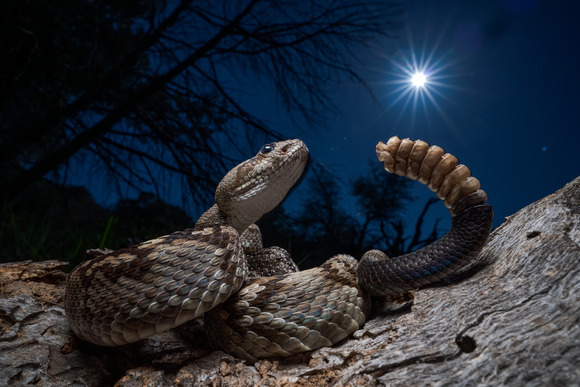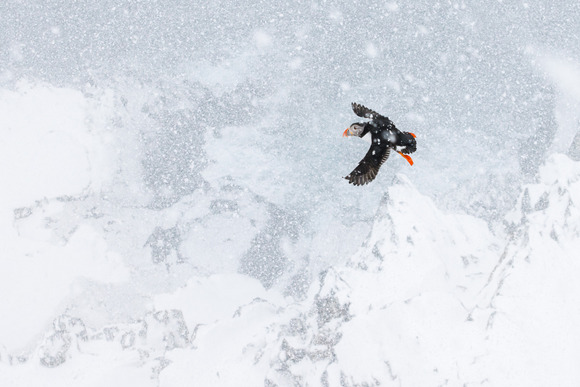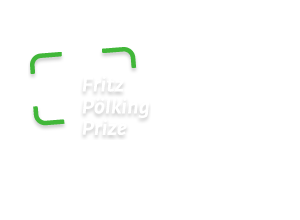FRITZ PÖLKING PRIZE AND FRITZ PÖLKING JUNIOR PRIZE 2025
The Spanish photographer Javier Aznar has won the Fritz Pölking Prize 2025. The photo essay Love, hate and rattlesnakes about the cultural and ecological significance of rattlesnakes on the one hand and snake hunting on the other hand greatly impressed the international jury.
The Fritz Pölking Junior Prize 2025 goes to Tobias Gjerde from Norway. His portfolio Norwegian winter is dedicated to the remarkably resilient animals that defy the extremes of Nordic winters.
Within the context of the European Wildlife Photographer of the Year competition, the German Society for Nature Photography (GDT) and Tecklenborg-Verlag have awarded this prize 18 times since the death of Fritz Pölking in 2007. The prize is awarded annually for an outstanding photographic work. Nature photography stories and portfolios are eligible.
Fritz Pölking Prize 2025

Javier Aznar | Project: Love, hate and rattlesnakes
Rattlesnakes have been revered as symbols of renewal and reviled as emissaries of the underworld. Hunted and harassed into the dark corners of our imagination, they evoke a mix
of fascination and fear. more...
Fritz Pölking Junior Prize 2025

Tobias Gjerde | Project: Norwegian winter
„When the snow blankets the ground, a bare, minimalist landscape emerges, as white as a canvas - a photographer's paradise, a nightmare for wildlife. [...]“ more...
Jury commentary
by Patrick Brakowsky (on behalf of the jury)
No matter how remote the landscape, how rare the species, or how extraordinary the natural phenomenon – nothing captured via nature photography is not influenced by our human worldview. Every photograph reflects the human viewpoint and is coloured by human experience and emotions. Photographs of wilderness are always, ultimately, interpretations and can never fully convey the experience in the field. That the boundaries between the natural and the human world are increasingly difficult to define has become ever more present in the work of nature photographers in recent decades – both on creative and narrative levels. It is, above all, this narrative dimension of nature photography that has fundamentally reshaped the way in which we view nature-related motifs. Perhaps, today, one could argue that a child gazing into a room full of rattlesnakes tells us more about our relationship with nature than a dramatic lion portrait set against a backdrop of the untamed savanna. The fear and fascination that shine side-by-side in the eyes of the child remind us that nature and humanity are intimately entangled, as evidenced by our far-reaching impact on the planet.
Once again, this year’s entries for the Fritz Pölking Prize competition ranged from breathtaking wildlife portraits to fascinating glimpses of animal behaviour, expertly composed landscapes, and views into rarely seen worlds. But as the jury drew closer to selecting a winner, it was the exploration of the intersection between humans and animals that left the strongest impression. In a competition of remarkable quality, our debates were lively. Yet in the end, the decision was unanimous: the ten images submitted by Spanish photographer Javier Aznar could not be topped.
Rarely has the winning series of the Fritz Pölking Prize brought us this close to the human dimension. The project Love, hate and rattlesnakes confronts us up front with how we interact with other species. It avoids mere shock tactics, instead offering a nuanced and multifaceted exploration of a complex subject. Remarkably – and perhaps for the first time in the history of this competition – each individual image is prize-worth in its own right. Yet, the series is far from a collection of individually excellent photographs. The photographer has achieved the rare feat of creating a cohesive, high-calibre visual narrative that does not shy away from hard facts.
While people feature prominently throughout his series, it is also clear that the trained biologist Aznar has a deep understanding of the behaviour and character of rattlesnakes. One striking image shows a rattlesnake at night, head raised and with its namesake tail pointing towards the moon. Another photograph captures how closely these animals coexist with us: a perfectly camouflaged snake lies just metres from a busy road high above a city. Aznar also presents the wide spectrum of contexts in which humans and snakes come into contact – from science and medicine to private collectors, and, last but not least, educational settings which focus on understanding instead of fear and persecution. It is this breadth of narrative that allows Javier to make his case: for a shift in perspective, so that these creatures may finally receive the respect they deserve.
Respect also defines the work of Norwegian photographer Tobias Gjerde in his series Norwegian winter. It is difficult for us, as humans, to comprehend what wildlife must endure during the long, harsh Nordic winter – snow, wind, and freezing temperatures in landscapes offering little shelter and no respite from the elements. For short periods of time, Gjerde ventured into these hostile environments. His images emphasise the scale of the wilderness that surrounds the animals. The image of a red fox, for instance, places the subject in the centre of the frame – a compositional choice that might conventionally be seen as a mistake. Here, the composition powerfully underlines the fox’s vulnerability in a vast white landscape.
The jury was impressed by how this young photographer managed to portray such a diversity of species while maintaining consistent visual and thematic clarity. Tobias’ handling of snow, wind, and the subdued hues of the northern winter, as well as his empathy for each species, is impressive. His series proves that there is no need for dramatic behaviour or fast action to tell a compelling story about isolation in an untamed wilderness.
The contrast between the award-winning projects of Javier Aznar and Tobias Gjerde could hardly be greater. And yet, together, the two series show the breadth and the potential of storytelling in nature photography. This work will hopefully inspire other photographers to widen their sights and pursue their subjects with both passion and empathy.
Unfortunately, a shadow was cast upon the excitement surrounding this year’s Fritz Pölking Prize. Just three weeks before the jury convened, Gisela Pölking passed away. As co-initator of the award, Gisela became integral to the jury after the death of her husband, Fritz. We are confident that both of this year’s winning series would have met with her wholehearted approval. The Fritz Pölking Prize will continue to honour the legacy of the Pölkings by championing the potential of nature photography to tell important stories.
This year's winning portfolios approach the topic of urban environments in very different ways. Each tells an interesting story with carefully composed images. All who take photographs in nature are witnesses to what is happening around us. Our cameras represent a powerful tool with which negative and positive developments can be documented and brought to the attention of a broad audience. We can only hope that in the future more photographers will undertake this admittedly time-consuming form of storytelling and perhaps decide to take part in the competition for the Fritz Pölking Prize.








